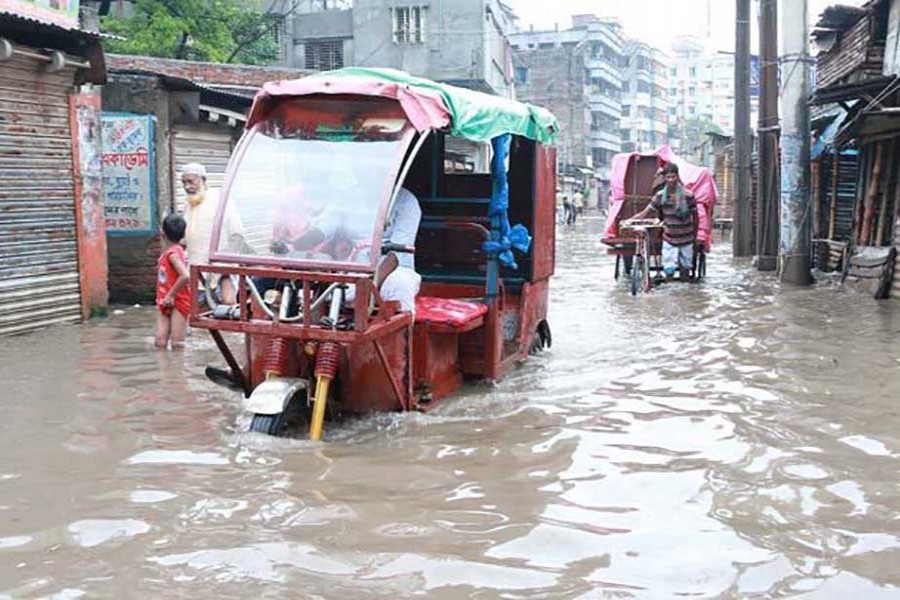The curse of Dhaka's monsoon waterlogging has for some time been plaguing the smaller cities and towns as well. These cities include district and divisional headquarters. A lot of upazila towns also become waterlogged during monsoons with heavy rainfall. These spectacles were veritably unthinkable one to one-and-half decades ago. Of late, the small Rangpur city got waterlogged with stagnant rainwater. The residents of the city, now a divisional headquarter, have witnessed the phenomenon in utter disbelief. According to the elderly segments of them, they have never been prepared to go through the ordeals prompted by the 24-hour incessant rainfall till September 27, 2020. According to the local Met office, the downpour had broken all records of the last 60 years.
Excessive rain doesn't always fall in the category of deviant behaviour of nature. Large cities like Dhaka have gone through these spells of day-and-night and 2-day-long rainfalls several times in its recent history. The first one battered the city in the early sixties with a bout of 12-inch (according to the measurement standard of the time) non-stop rain in a single night. The city residents experienced such hours-long downpour in the years of 2000-2015. With the rain over, the capital emerged as submerged in knee- to waist-deep stagnant water. By that time, Dhaka had become notorious for its waterlogged roads, neighbourhoods and low-lying areas. Surprisingly, the night-long rain in the 1960s did not cause any waterlogging. Whatever rainwater collected in some city areas receded within hours. These days, the stagnant and foul-smelling waters after a prolonged shower cause untold sufferings to both the pedestrians and vehicle movements. Low-lying areas remain marooned for weeks in a row.
Insufficient storm sewerage, faulty drainage and mindless hindrances to the smooth flowing out of water are routinely blamed for Dhaka's ever-worsening waterlogging. In spite of nonstop media uproar, citizens' remedial seminars, expert-level roundtable etc, there have been little signs of the waterlogging menace fully disappearing from Dhaka. As an old ritualistic exercise, the agencies concerned have kept blaming each other for the capital's perennial inundation.
Compared to the dreadful scenes of waterlogging in Dhaka, as well as today's Chattogram, the smaller cities have lately begun experiencing the ordeal of waterlogging. Seeing their cities submerged in stagnant rain water for a couple of days, the residents begin bracing for worse times ahead of every monsoon. Presently, a sizeable number of district headquarters,out of 64, remain afflicted with various degrees of monsoon waterlogging every year. As has been found in the capital for around three decades, these small to medium urban centres have started finding themselves beset by the urban woes similar to that of Dhaka. The same old infrastructural faults related to flushing out of rain water into nearby rivers, canalsor swamps routinely plague these cities. Many of these age-old urban centres once boasted of their networks of canals dug out to keep the city hearts free of rain water.
As time wore on and it entered the 'modern era', the floodgates of corrupt practices were made to fling open. Dominant of them was the filling of the canals to build structures on them. They accompanied constructing drainage systems sloppily, the authorities' turning a blind eye to the common practice of dumping all kinds of waste into the canals or rivers and creating hindrances to rain water's flowing into designated places. These practices have these days become the norm like they have in the capital.
Once upon a time lots of people would dream of settling down in a small district town. They looked for a place where the urban amenities are available, yet free of the frenzied consumerism and the frenetic rat race for mundane happiness. Some towns met these prerequisites. But in time the disillusioned people discovered the dreadful replication of the big city ills in their once tranquil retreats. The most tormenting of these menaces turned out to be waterlogging and the powerful syndicatesabetting it.
Given their pace of deterioration in almost every sector, planners of big cities find these smaller urban points to be the new centres of intractability and aberration --- not much different from that seen in the unwieldy capital of the country. What startles the conscious segments of the people is the eventual disappearance of peaceful life from even the upazila towns. Many of them have their own shares of waterlogging and other big city menaces. Idyllic settlements in the country keep squeezing, with many responding gleefullyto the temptations of being the residents of complete towns. In order to reach that goal, they have to erase all the vestiges of the rural or suburban way of living.
A highly depressing fact is almost all small towns in the country are beset with the widespread scourge of monsoon waterlogging. Few could have imagined it even a decade back. Except a handful of such towns thriving on higher land, the inhabitants of the country's districts and upazilas (sub-districts) these days start bracing for the inundation of their low-lands and many roads with the approach of the rainy season. It doesn't require probe committees to identify the failures of the municipal authorities concerned for these localised monsoon submersions. According to media reports, nowadays villages are also seen falling victim to this menace.
In getting to the roots of the worsening menace, the same old picture as found in the large cities comes up. It comprises improvised and malfunctioning drainage, grabbing of the vital rain-water flushing mid-town rivers or canals, unplanned building spree and many other ills related to frenzied urbanisation. Nowadays, scores of small towns in the highly developed countries fall victim to yearly waterlogging caused by spillover of water from the rain-fed rivers nearby. These waterlogging menaces are caused by nature's erratic behaviour. In contrast, the deluges in the least developed cities and small towns are mostly human-induced.


